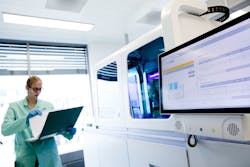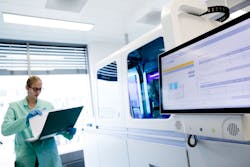Navigating a successful laboratory automation implementation
By simplest definition, implementing laboratory automation involves the conversion from analog to technology-based solutions with the objectives of streamlining processes, increasing efficiencies, reducing errors, and improving overall workflow. The degree to which the conversion can be deemed successful is dependent upon three key factors: 1. effective change management, 2. lab and IT staff collaboration, and 3. consistent leadership before, during, and after implementation occurs.
Why automation?
As labs continue to grow larger in size through consolidation, and staffing resources simultaneously shrink due to high attrition and retirement rates, automation is quickly becoming a necessity for facilities that want to remain profitable in a highly competitive marketplace. Laboratorians who resist the concept of automation may very well find their operations lagging behind the curve as their counterparts outpace them in terms of quality and productivity.
Consolidation trends show no signs of slowing, leading to the creation of more high-volume and core labs. This creates a larger workload for fewer people to manage, supporting the need for automation in order to keep up with volume.
Now more than ever, labs are being challenged to meet increasingly stringent performance expectations that aren’t always attainable through increased staff effort or general process improvements. Automation affords lab management the capability to help meet this growing demand. While it may not necessarily produce faster test turnaround times (TATs)—a key performance metric for many labs—automation does go a long way toward enabling reproducible TATs, which can contribute to improved clinician satisfaction.
The potential benefits of automation go well beyond consistent TATs, extending into improved test result reliability, cost and time savings, streamlined processing, and greater quality performance. Perhaps most importantly, automation can enable the clinical lab to make a bigger contribution to the overall goal of better patient care, offering empirical evidence that demonstrates the lab’s value to healthcare system administrators.
So, what is it that specifically determines and drives an effective implementation? Every laboratory has its own unique set of needs and challenges, but generally speaking, success at many labs seems to hinge upon three critical elements.
1. Change management
Thoughtful change management is absolutely essential to prepare and support individuals and teams through an effective changeover to automated processes.
Good communication is key. Change management efforts should begin as soon as the decision to automate is confirmed by communicating information to all internal and external stakeholders who will be impacted by the implementation. This includes not only lab staff and managers, but other departments and teams as well. For instance, implementation may necessitate changes to barcode labeling and other related processes, or it might create the need to revisit sample collection procedures. To smooth the transition, it’s important to convey all relevant updates and information on a timely basis, and to keep the lines of communication open throughout and after implementation to minimize the potential for conflicts to arise.
Resistance to change is a commonly seen issue in the clinical lab setting, and the prospect of implementing new automated processes can invoke a sense of fear and trepidation among some staff members. The transition to automation may require some laboratorians to undergo a critical shift in thinking and work approach. One of the biggest challenges that implementation presents is an underestimation of the need for the softer-skills aspects of change management. Data-driven laboratorians who readily understand the technical aspects of their jobs such as analytics, correlation, and validation efforts may be resistant to embrace the major paradigm shift that automation entails, fearing these new technologies will render their roles obsolete.
Reassurance that includes the rationale for and benefits of switching over to automation can go a long way toward overcoming objections, easing fears, and creating buy-in among hesitant laboratorians. It’s also worth pointing out that automation can actually free up lab staff from the constraints of time-consuming routine process steps to focus on higher-value tasks.
Additionally, the automation implementation process can provide a valuable opportunity to review the lab’s current design and layout to look for areas where process improvements may be warranted. Automation can quickly reveal any inefficiencies and weaknesses that need to be addressed in the overall workflow. New interim procedures may need to be instituted during the transitional phase of implementation, and staff should be made aware that it can take some time and tweaking before peak automation efficiency is achieved. It is essential to engage staff during these process re-mapping exercises, as they are the people who understand the laboratory’s workflow better than anyone.
2. Information technology
The very foundation of automation is deeply rooted in state-of-the-art technology, putting IT departments in a vital position to help accomplish a successful implementation. The automation vendor and the lab manager should each identify what role their own IT staff will play early in the pre-sale process, addressing current status, all supportive measures the proposed solution will require, and any resources that can be made available. It is usually incumbent upon the vendor to identify the lab’s IT capabilities through discussions regarding the automation solution, but the lab manager and staff must also gain a firm understanding of the supports and tools they will need to provide on their end to facilitate the implementation process.
The laboratory and vendor IT staff should plan to work together as a team to achieve the best automation results possible. Often, the automation vendor can provide training throughout the implementation that will teach the lab’s own IT department how to offer optimal support after go-live and into post-implementation activities.
Recognize that, while automation systems often employ highly sophisticated features and functionalities, certain labs may not be able to leverage the full capabilities of the system due to limitations of their laboratory information systems. For this reason, labs should reasonably assess which solutions are the most practical and realistic for their organizations considering their own capacities and capabilities. Vendors may be able to present ideas focused on overcoming obstacles and helping create feasible
workarounds wherever possible.
3. Leadership teams
All key players are important during the conversion to automation, but the success of any team effort depends heavily on its management and leadership. Viewing the implementation solution as a total symbiotic system and not just the collection of individual components (automation, chemistry analyzers, hematology platforms, etc.) is a helpful mindset to maintain.
Developing a lean-dedicated leadership team that can effectively function to see the implementation process through from start to finish helps to dissolve silos and fosters a collaborative atmosphere in which everyone involved in the implementation is invested in its success. The leadership team should be comprised of representatives from across the lab and throughout the disciplines that are directly impacted by the solution, such as processing, chemistry, hematology/coagulation, and any others.
The takeaway
While automation may sometimes seem like a magic wand with the power to transform the lab into a perfect, error-free facility at the flip of a switch, keep in mind that technology is only as effective as the people who manage it. It helps to think of automation as a tool with the potential to help lab staff do their jobs better and optimize efficiency; human input is still required to drive the result.
Ultimately, automation is intended to enhance the skills and value of human staff, not replace them. Thus, the onus is on automation vendor partners to create reasonable expectations for laboratory staff, and to provide support during and after the implementation to continuously monitor the outcome and make ongoing adjustments as needed to ensure long-term success. Conversely, it is the responsibility of lab management to foster a culture of continuous improvement so that the tools, processes, and staff are enabled and empowered to adapt to inevitable changes in the lab.
About the Author

Harold D. Lanzoni
serves as a Strategic Workflow Consultant with Roche Diagnostics who brings 30 years of laboratory experience and Lean/Six Sigma principles to his consultations with clinical labs. He works with labs to identify opportunities and strategies to improve operational efficiency and quality.


